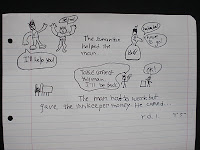Several measures have been taken against violence on the streets, both by the US Police and church members, prayer groups, common citizens.
http://au.video.yahoo.com/watch/7815267
http://au.video.yahoo.com/watch/7905739/19238920
An anti-violence movement called ENOUGH IS ENOUGH encourages people to become part of the solution,
http://enoughisenough.org.au/
Sunday, September 26, 2010
VIOLENCE - VIOLÊNCIA

What do we understand under VIOLENCE?
O que entendemos por VIOLÊNCIA?
What feelings, emotions are associated with violence?
Que sentimentos, emoções são despoletados pela violência?
Can we spot violence in a photo, in a situation, in a Bible text?
Podemos perceber a existência de violência numa foto, numa situação, numa narrativa bíblica?
What kinds of violence are there?
Que tipos de violência conhecemos?
Let's start by referring violence in a school context.
Comecemos por referir a violência em contexto escolar.
Comment the following cartoon.
Comente o cartoon seguinte.
Does it relate to the topic Violence in any way?
Tem a ver alguma coisa com o tópico Violência?
The Parable of The Good Samaritan/A Parábola do Bom Samaritano - What is it about? É sobre o quê?



The Parable of the Good Samaritan is precipitated by and in answer to a question posed to Jesus by a lawyer,
"Teacher, what shall I do to inherit eternal life?" (Luke 10:25).
In this case the lawyer would have been an expert in the Mosaic Law and not a court lawyer of today.
This question provided Jesus with an opportunity to define what His disciples' relationship should be to people in distress. Jesus focuses on relationships and what it means to be someone's neighbour.
The text says that the scribe (lawyer) had put the question to Jesus as a test. The scribe was making the assumption that man must do something to obtain eternal life. Jesus will answer the question using what is called the Socratic method; i.e. answering a question with a question, “He said to him, "What is written in the law? What is your reading of it?" (Luke 10:26). By referring to the Law, Jesus is directing the man to an authority they both would accept as truth, the Old Testament. The scribe answers Jesus’ question by quoting Deuteronomy 6:5 and Leviticus 19:18.
Here are some simple illustrations by students.
Marcadores:
meanings,
O Bom Samaritano,
significados,
The Good Samaritan
Do not let the sun go down on your anger- Não deixes que o dia termine sem resolveres a tua zanga/ira
Marcadores:
anger,
Bible. Bíblia,
forgiveness,
ira,
perdão,
valores,
values
Sunday, September 19, 2010
The Jesus Storybook Bible - O Livro de Histórias de Jesus
link/apontador:
Subscribe to:
Posts (Atom)

